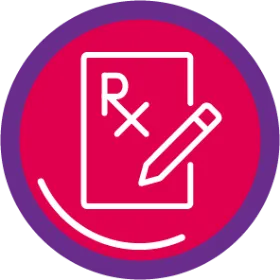Resources for your patients
Resources for your patients and their caregivers
The following resources can be used to provide patients and caregivers with key information on FINTEPLA.
Are you looking for resources
for prescribers?
The following materials can be downloaded and shared with your patients’ caregivers. Click the ![]() button to generate an email to send a brochure to the caregiver directly.
button to generate an email to send a brochure to the caregiver directly.
Learn about FINTEPLA for Dravet syndrome
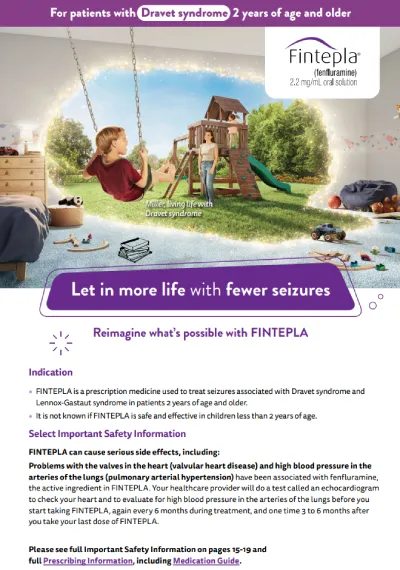
FINTEPLA for Dravet Syndrome Caregiver Brochure
Provides information for caregivers considering starting their loved one with Dravet syndrome on FINTEPLA
Learn about FINTEPLA for LGS
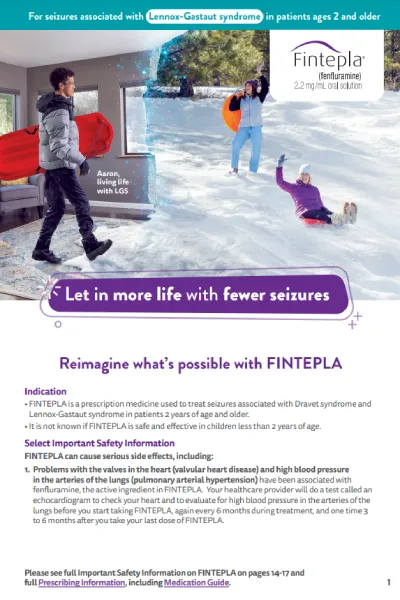
FINTEPLA for LGS Caregiver Brochure
Provides information for caregivers considering starting their loved one with LGS on FINTEPLA
Learn about echocardiograms
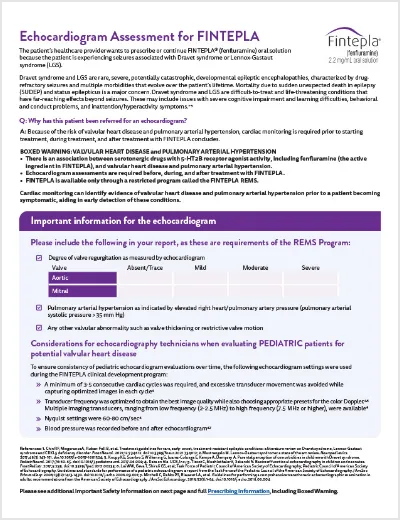
Echocardiogram Assessment Sheet
Caregivers should give this to the electrocardiography staff when they go for an echocardiogram test

Preparing for Echocardiograms Brochure
Provides caregivers with detailed information about echocardiogram tests

Fin & Willow Echocardiogram Book
Caregivers can use this engaging storybook to help prepare their loved one for their echocardiogram
Additional resources
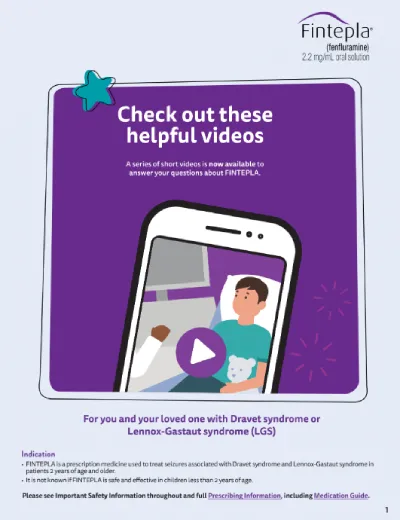
Brochure Listing Available Caregiver Videos
Outlines a series of videos that are available for your patients on topics such as financial support programs, the REMS, dosing, and more
The following materials can be downloaded and shared with your patients’ caregivers. Click the ![]() button to generate an email to send a brochure to the caregiver directly.
button to generate an email to send a brochure to the caregiver directly.

ONWARD™ Financial/Copay Assistance Program
Provides caregivers with information about the ONWARD financial/copay assistance program
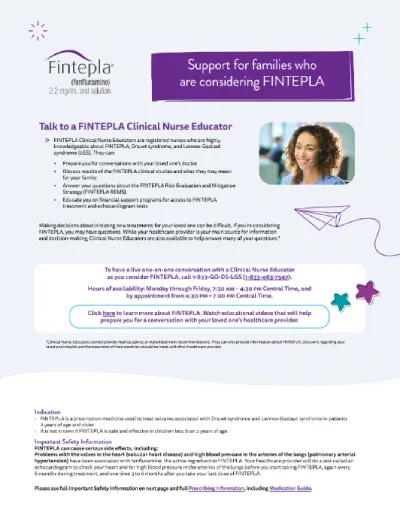
FINTEPLA Clinical Nurse Educator (CNE) Flashcard
Explains how the CNEs can support caregivers who are considering FINTEPLA for their loved one
The following videos with patient stories and information about Dravet syndrome and FINTEPLA can be shared with your patients’ caregivers.
Taking FINTEPLA
Finding the right dose and managing side effects with Dravet syndrome

Getting started with FINTEPLA
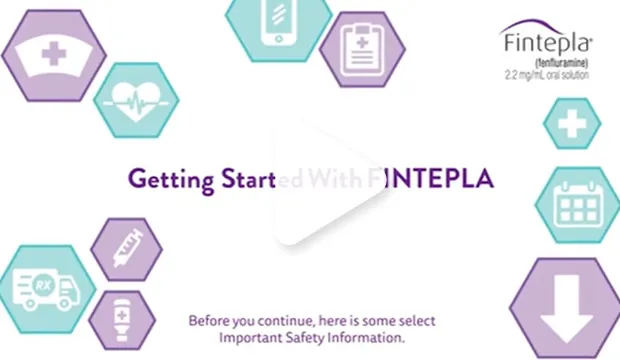
FINTEPLA fits into your loved one’s treatment plan
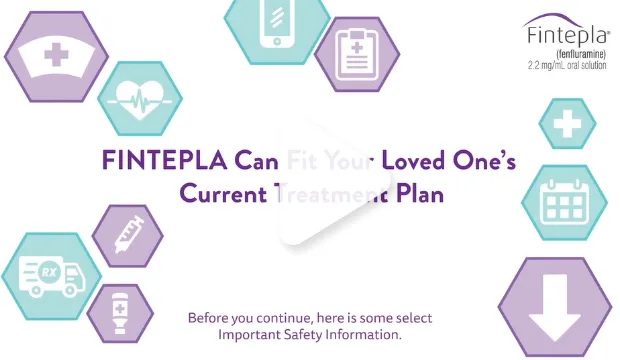
Learn about echocardiograms
Learn about echocardiograms from Bethany and Kye
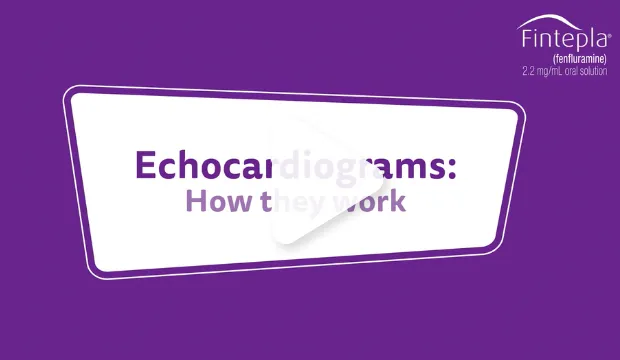
Tips for your loved one’s first echocardiogram
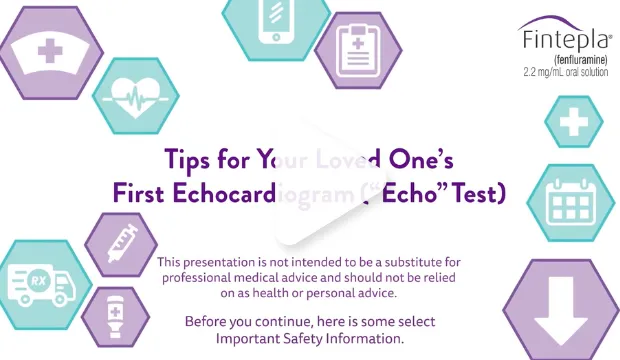
Safety
Your loved one’s safety comes first

Risk Evaluation and Mitigation Strategy (REMS)
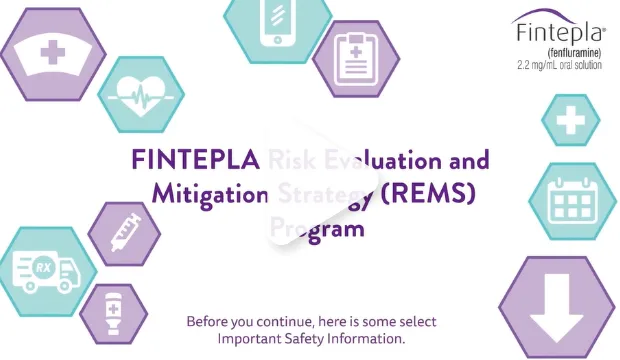
FINTEPLA support
Financial support programs for access to FINTEPLA
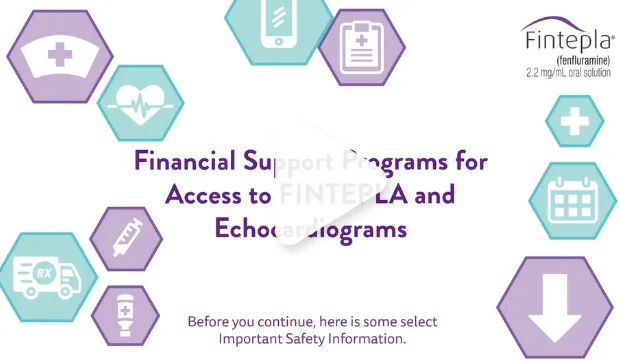
The following videos with patient stories and information about LGS and FINTEPLA can be shared with your patients’ caregivers.
Taking FINTEPLA
Finding the right dose and managing side effects with LGS
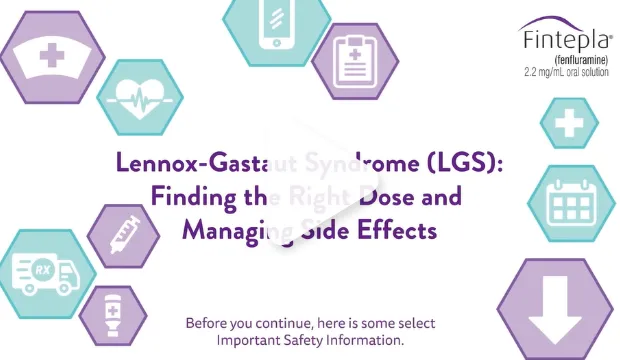
Getting started with FINTEPLA

FINTEPLA fits into your loved one’s treatment plan

Learn about echocardiograms
Learn about echocardiograms from Bethany and Kye

Tips for your loved one’s first echocardiogram

LGS webinar
Learn about FINTEPLA from Beck Reyes, NP
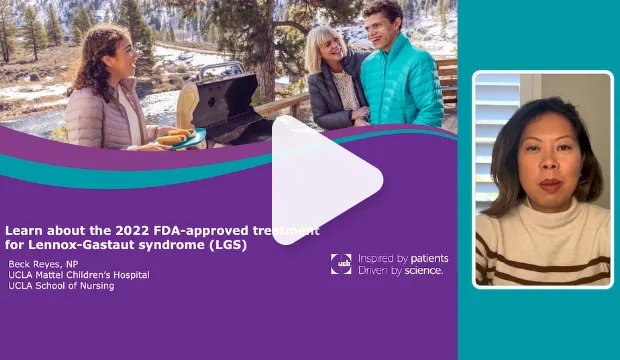
Safety
Your loved one’s safety comes first

Risk Evaluation and Mitigation Strategy (REMS)

FINTEPLA support
Financial support programs for access to FINTEPLA

Important contact information
Frequently asked questions1
FINTEPLA is indicated for the treatment of seizures associated with Dravet syndrome and Lennox-Gastaut syndrome (LGS) in patients 2 years of age and older.
In the randomized, double-blind, placebo-controlled trials of FINTEPLA in Dravet syndrome, convulsive seizure types assessed included tonic, clonic, generalized tonic-clonic (GTC), tonic-atonic, secondarily GTC, hemiclonic, and focal with observable motor signs.
In the randomized, double-blind, placebo-controlled trial of FINTEPLA in LGS, the primary endpoint was the change in frequency of the following seizure types that were confirmed by The Epilepsy Study Consortium to have resulted in a drop, fall, or injury: generalized tonic-clonic (GTC), secondarily GTC, tonic, atonic, and tonic-atonic.
Patients on a ketogenic diet were included in the clinical studies. FINTEPLA is compatible with a ketogenic diet and contains no ingredient made from gluten-containing grain (wheat, barley, or rye) and not more than 0.1% of carbohydrates, which is solely derived from the cherry flavor.
Most patients do not need to have a cardiology consultation in order to get an echocardiogram, which can be ordered as a screening test, just like other screening procedures. However, certain epilepsy centers require that an epileptologist refer a patient to a cardiologist in order to get an echocardiogram.
UCB is committed to making FINTEPLA affordable and accessible for patients through financial assistance programs. Patients may pay as little as $0 in out-of-pocket costs for FINTEPLA and echocardiograms. Most families will not pay more than $25 in out-of-pocket copays for FINTEPLA.* For more information about these financial assistance programs, including eligibility criteria, call 1-833-GO-DS-LGS (1-833-463-7547).
*Subject to eligibility; individual out-of-pocket costs may vary. See full Terms and Conditions.
UCB strives to make the FINTEPLA Risk Evaluation and Mitigation Strategy (REMS) as accessible as possible. That’s why UCB has established a network of sonographers who can travel directly to eligible patients who are unable to access an echocardiogram (echo) facility due to their geographic location or disease-related limitations. Full eligibility Terms and Conditions apply.*
*Eligibility Terms and Conditions: The At-home Echo Program is intended to assist certain eligible patients who have been prescribed FINTEPLA to obtain an echocardiogram assessment in accordance with the product labeling and the FINTEPLA REMS, as required by the US Food and Drug Administration. To be eligible for the program, a patient (or their caregiver) must attest that they are unable to safely access a qualified healthcare provider’s office for an echocardiogram due to their geographic location or disease-related limitations. Participating patients, caregivers, and/or healthcare providers may not submit any claims for reimbursement to any third-party payer for echocardiograms provided through the program. The program may be amended or canceled at any time without notice.
Reference
1. FINTEPLA (fenfluramine) oral solution: U.S. prescribing information. Smyrna, GA: UCB, Inc.
Important Safety Information
See moreBOXED WARNING: VALVULAR HEART DISEASE and PULMONARY ARTERIAL HYPERTENSION
- There is an association between serotonergic drugs with 5-HT2B receptor agonist activity, including fenfluramine (the active ingredient in FINTEPLA), and valvular heart disease and pulmonary arterial hypertension.
- Echocardiogram assessments are required before, during, and after treatment with FINTEPLA.
- FINTEPLA is available only through a restricted program called the FINTEPLA REMS.
CONTRAINDICATIONS
FINTEPLA is contraindicated in patients with hypersensitivity to fenfluramine or any of the excipients in FINTEPLA and with concomitant use, or within 14 days of the administration, of monoamine oxidase inhibitors because of an increased risk of serotonin syndrome.
WARNINGS AND PRECAUTIONS
Valvular Heart Disease and Pulmonary Arterial Hypertension (see Boxed Warning): Because of the association between serotonergic drugs with 5-HT2B receptor agonist activity, including fenfluramine (the active ingredient in FINTEPLA), and valvular heart disease (VHD) and pulmonary arterial hypertension (PAH), cardiac monitoring via echocardiogram is required prior to starting treatment, during treatment, and after treatment with FINTEPLA concludes. Cardiac monitoring via echocardiogram can aid in early detection of these conditions. In clinical trials for DS and LGS of up to 3 years in duration, no patient receiving FINTEPLA developed VHD or PAH.
Monitoring: Prior to starting treatment, patients must undergo an echocardiogram to evaluate for VHD and PAH. Echocardiograms should be repeated every 6 months, and once at 3-6 months post treatment with FINTEPLA.
The prescriber must consider the benefits versus the risks of initiating or continuing treatment with FINTEPLA if any of the following signs are observed via echocardiogram: valvular abnormality or new abnormality; VHD indicated by mild or greater aortic regurgitation or moderate or greater mitral regurgitation, with additional characteristics of VHD (eg, valve thickening or restrictive valve motion); PAH indicated by elevated right heart/pulmonary artery pressure (PASP >35 mmHg).
FINTEPLA REMS Program (see Boxed Warning): FINTEPLA is available only through a restricted distribution program called the FINTEPLA Risk Evaluation and Mitigation Strategy (REMS) Program. Prescribers must be certified by enrolling in the FINTEPLA REMS. Prescribers must counsel patients receiving FINTEPLA about the risk of VHD and PAH, how to recognize signs and symptoms of VHD and PAH, the need for baseline (pretreatment) and periodic cardiac monitoring via echocardiogram during FINTEPLA treatment, and cardiac monitoring after FINTEPLA treatment. Patients must enroll in the FINTEPLA REMS and comply with ongoing monitoring requirements. The pharmacy must be certified by enrolling in the FINTEPLA REMS and must only dispense to patients who are authorized to receive FINTEPLA. Wholesalers and distributors must only distribute to certified pharmacies. Further information is available at www.FinteplaREMS.com or by telephone at 1-877-964-3649.
Decreased Appetite and Decreased Weight: FINTEPLA can cause decreases in appetite and weight. Decreases in weight appear to be dose related. Approximately half of the patients with LGS and most patients with DS resumed the expected measured increases in weight during the open-label extension studies. Weight should be monitored regularly during treatment with FINTEPLA, and dose modifications should be considered if a decrease in weight is observed.
Somnolence, Sedation, and Lethargy: FINTEPLA can cause somnolence, sedation, and lethargy. Other central nervous system (CNS) depressants, including alcohol, could potentiate these effects of FINTEPLA. Prescribers should monitor patients for somnolence and sedation and should advise patients not to drive or operate machinery until they have gained sufficient experience on FINTEPLA to gauge whether it adversely affects their ability to drive or operate machinery.
Suicidal Behavior and Ideation: Antiepileptic drugs (AEDs), including FINTEPLA, increase the risk of suicidal thoughts or behaviors in patients taking these drugs for any indication. Patients treated with an AED for any indication should be monitored for the emergence or worsening of depression, suicidal thoughts or behaviors, or any unusual changes in mood or behavior.
Anyone considering prescribing FINTEPLA or any other AED must balance the risk of suicidal thoughts or behaviors with the risks of untreated illness. Epilepsy and many other illnesses for which AEDs are prescribed are themselves associated with morbidity and mortality and an increased risk of suicidal thoughts and behaviors. Should suicidal thoughts and behaviors emerge during treatment, consider whether the emergence of these symptoms in any given patient may be related to the illness being treated.
Withdrawal of Antiepileptic Drugs: As with most AEDs, FINTEPLA should generally be withdrawn gradually because of the risk of increased seizure frequency and status epilepticus. If withdrawal is needed because of a serious adverse reaction, rapid discontinuation can be considered.
Serotonin Syndrome: Serotonin syndrome, a potentially life-threatening condition, may occur with FINTEPLA, particularly during concomitant administration of FINTEPLA with other serotonergic drugs, including, but not limited to, selective serotonin-norepinephrine reuptake inhibitors (SNRIs), selective serotonin reuptake inhibitors (SSRIs), tricyclic antidepressants (TCAs), bupropion, triptans, dietary supplements (eg, St. John’s Wort, tryptophan), drugs that impair metabolism of serotonin (including monoamine oxidase inhibitors [MAOIs], which are contraindicated with FINTEPLA), dextromethorphan, lithium, tramadol, and antipsychotics with serotonergic agonist activity. Patients should be monitored for the emergence of signs and symptoms of serotonin syndrome, which include mental status changes (eg, agitation, hallucinations, coma), autonomic instability (eg, tachycardia, labile blood pressure, hyperthermia), neuromuscular signs (eg, hyperreflexia, incoordination), and/or gastrointestinal symptoms (eg, nausea, vomiting, diarrhea). If serotonin syndrome is suspected, treatment with FINTEPLA should be stopped immediately and symptomatic treatment should be started.
Increase in Blood Pressure: FINTEPLA can cause an increase in blood pressure. Rare cases of significant elevation in blood pressure, including hypertensive crisis, has been reported in adult patients treated with fenfluramine, including patients without a history of hypertension. In clinical trials for DS and LGS of up to 3 years in duration, no pediatric or adult patient receiving FINTEPLA developed hypertensive crisis. Monitor blood pressure in patients treated with FINTEPLA.
Glaucoma: Fenfluramine can cause mydriasis and can precipitate angle closure glaucoma. Consider discontinuing treatment with FINTEPLA in patients with acute decreases in visual acuity or ocular pain.
ADVERSE REACTIONS
The most common adverse reactions observed in DS studies (incidence at least 10% and greater than placebo) were decreased appetite; somnolence, sedation, lethargy; diarrhea; constipation; abnormal echocardiogram; fatigue, malaise, asthenia; ataxia, balance disorder, gait disturbance; blood pressure increased; drooling, salivary hypersecretion; pyrexia; upper respiratory tract infection; vomiting; decreased weight; fall; status epilepticus.
The most common adverse reactions observed in the LGS study (incidence at least 10% and greater than placebo) were diarrhea; decreased appetite; fatigue; somnolence; vomiting.
DRUG INTERACTIONS
Strong CYP1A2, CYP2B6, or CYP3A Inducers: Coadministration with strong CYP1A2, CYP2B6, or CYP3A inducers will decrease fenfluramine plasma concentrations. If coadministration of a strong CYP1A2, CYP2B6, or CYP3A inducer with FINTEPLA is necessary, monitor the patient for reduced efficacy and consider increasing the dosage of FINTEPLA as needed. If a strong CYP1A2, CYP2B6, or CYP3A inducer is discontinued during maintenance treatment with FINTEPLA, consider gradual reduction in the FINTEPLA dosage to the dose administered prior to initiating the inducer.
Strong CYP1A2 or CYP2D6 Inhibitors: Coadministration with strong CYP1A2 or CYP2D6 inhibitors will increase fenfluramine plasma concentrations. If FINTEPLA is coadministered with strong CYP1A2 or CYP2D6 inhibitors, the maximum daily dosage of FINTEPLA is 20 mg. If a strong CYP1A2 or CYP2D6 inhibitor is discontinued during maintenance treatment with FINTEPLA, consider gradual increase in the FINTEPLA dosage to the dose recommended without CYP1A2 or CYP2D6 inhibitors. If FINTEPLA is coadministered with stiripentol and a strong CYP1A2 or CYP2D6 inhibitor, the maximum daily dosage of FINTEPLA is 17 mg.
USE IN SPECIFIC POPULATIONS
In patients with severe impairment of kidney function (estimated glomerular filtration rate [eGFR]) 15 to 29 mL/min/1.73m2, dosage adjustments are recommended. FINTEPLA has not been studied in patients with kidney failure (eGFR <15 mL/min/1.73m2).
Combined molar exposures of fenfluramine and norfenfluramine were increased in subjects with various degrees of hepatic impairment (Child-Pugh Class A, B, and C), necessitating a dosage adjustment in these patients.
To report SUSPECTED ADVERSE REACTIONS, contact UCB, Inc. at 1‑844-599-2273 or FDA at 1-800-FDA-1088 or www.fda.gov/medwatch.
Please see full Prescribing Information, including Boxed Warning, for additional Important Safety Information on FINTEPLA.











